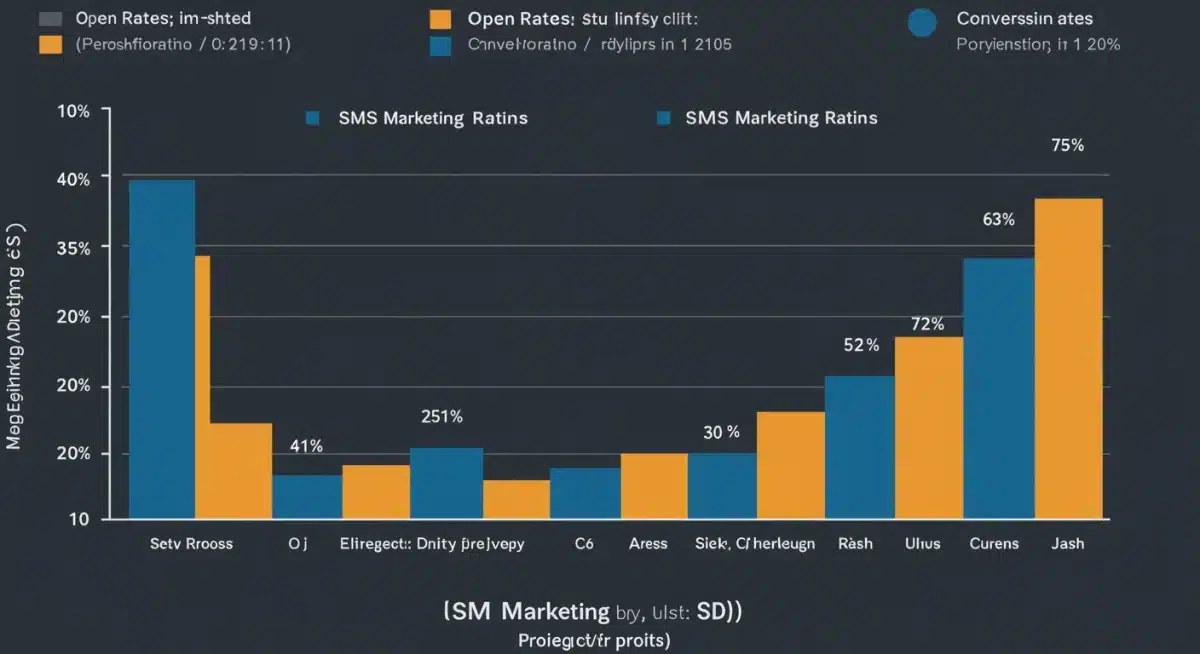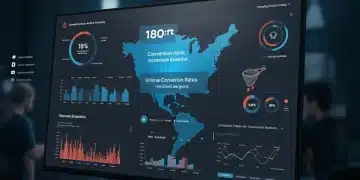Email Marketing vs. SMS Marketing in the US: 2025 Performance Analysis

This 2025 analysis evaluates the performance of email marketing against SMS marketing in the US, detailing current trends, engagement rates, and strategic advantages for businesses.
As businesses in the United States look to optimize their digital outreach, the ongoing debate between email and SMS marketing intensifies. A comprehensive Email Marketing vs. SMS Marketing in the US: A 2025 Performance Analysis is crucial for understanding which channel delivers superior engagement and return on investment in the rapidly evolving digital landscape.
The Evolving Landscape of Digital Communication in 2025
The digital communication arena in 2025 is characterized by heightened consumer expectations and stricter privacy regulations. Marketers are constantly refining their strategies to cut through the noise and deliver impactful messages. Both email and SMS channels have undergone significant transformations, adapting to AI-driven personalization and real-time analytics, as reported by industry leaders in digital marketing.
Recent data indicates a shift in how consumers interact with promotional content. While email remains a cornerstone for detailed communication, SMS has cemented its position for immediate, urgent, and concise interactions. This dynamic necessitates a nuanced understanding of each channel’s strengths and weaknesses, especially as we approach the mid-point of the decade.
Key Trends Shaping Email Marketing Performance
- Hyper-Personalization: AI-powered segmentation and content customization are boosting email open rates and click-through rates substantially.
- Interactive Email Content: Embedded videos, quizzes, and dynamic product carousels are driving higher engagement within email campaigns.
- Privacy-First Design: Marketers are prioritizing transparent data practices, leading to increased subscriber trust and longer-term loyalty.
SMS Marketing’s Ascent in Urgency and Immediacy
SMS marketing continues to leverage its inherent immediacy, proving effective for time-sensitive promotions, alerts, and transactional messages. Its high open rates, often surpassing 90% within minutes of delivery, make it an indispensable tool for urgent communications. However, the brevity required for SMS content presents unique challenges for conveying complex information or building rich brand narratives.
ROI and Conversion Metrics: A Deep Dive for 2025
Analyzing the Return on Investment (ROI) and conversion metrics for both email and SMS marketing in 2025 reveals distinct patterns. Email marketing, while requiring more effort in content creation, often yields a higher average order value (AOV) due to its capacity for detailed product presentations and storytelling. SMS, conversely, excels in driving immediate, smaller-ticket purchases or quick actions, such as appointment reminders or flash sales.
Current projections from marketing analytics firms suggest that email marketing maintains a strong ROI, averaging around $36 for every dollar spent, largely thanks to its automation capabilities and long-term customer nurturing potential. SMS marketing, while having a slightly lower reported ROI per message due to volume and cost, often boasts superior conversion rates for specific, targeted campaigns, particularly in retail and services.
Understanding Email Conversion Funnels
Email conversion funnels typically involve multiple touchpoints, guiding users from awareness to purchase through a series of carefully crafted messages. This allows for comprehensive product education and overcoming potential objections, ultimately leading to higher-value conversions. The ability to track detailed analytics, from open rates to individual link clicks, provides invaluable insights for continuous optimization.
SMS Conversion: Speed and Simplicity
The conversion path for SMS is often much shorter, capitalizing on impulse and immediate needs. A simple call to action (CTA), such as ‘Reply YES to confirm’ or ‘Click to buy now,’ can yield rapid results. This channel’s effectiveness lies in its directness and minimal friction, making it ideal for quick, high-volume transactions where speed is paramount.


Audience Segmentation and Personalization Strategies
Effective audience segmentation and personalization are non-negotiable for both email and SMS marketing success in 2025. Generic, mass communications are increasingly ineffective and can lead to high unsubscribe rates. Leveraging customer data to tailor messages ensures relevance, which is critical for engagement and conversion.
For email, advanced segmentation can involve demographic data, purchase history, browsing behavior, and engagement levels. This allows for highly specific campaigns, such as abandoned cart reminders with personalized product recommendations or loyalty programs based on past purchases. The richness of email content supports this level of detailed personalization.
Granular Targeting in Email Campaigns
- Behavioral Segmentation: Targeting users based on their interactions with previous emails or website activity.
- Lifecycle Segmentation: Delivering specific content based on where a customer is in their journey (e.g., welcome series, re-engagement campaigns).
- Preference Centers: Allowing subscribers to choose the types of content they receive, enhancing satisfaction and reducing opt-outs.
Precision in SMS Personalization
SMS personalization, while constrained by character limits, focuses on immediate relevance. This includes using the recipient’s name, referencing recent interactions, or providing location-specific offers. The goal is to make each message feel exclusive and directly applicable to the individual, maximizing the likelihood of a quick response.
Compliance and Regulations: Navigating the Legal Landscape
The regulatory environment for digital marketing communications in the US continues to evolve, with significant implications for both email and SMS. Compliance with acts like the CAN-SPAM Act for email and the TCPA (Telephone Consumer Protection Act) for SMS is paramount. Non-compliance can result in substantial fines and damage to brand reputation. As of early 2025, there’s an increased focus on explicit consent and clear opt-out mechanisms.
For email, clear unsubscribe links and transparent privacy policies are standard. For SMS, the requirements are even more stringent, demanding explicit opt-in, clear disclosure of message frequency, and easy opt-out instructions (e.g., ‘Text STOP to unsubscribe’). Businesses must stay updated on these regulations, as legal frameworks are continually being refined to protect consumer privacy and combat unsolicited communications.
Email Marketing Compliance Essentials
Adhering to email marketing regulations involves several critical steps. Beyond clear consent, marketers must ensure accurate header information, legitimate reply addresses, and a physical postal address. Regular audits of subscriber lists and consent records are also becoming standard practice to mitigate legal risks.
Stringent Rules for SMS Campaigns
- Double Opt-in: Many businesses are adopting double opt-in processes for SMS to ensure unequivocal consent.
- Clear Disclosure: Informing subscribers about message frequency and potential data rates upfront.
- Easy Opt-Out: Providing simple, universally understood methods for customers to stop receiving messages.
Integration and Synergy: The Power of a Unified Strategy
While this analysis often frames email and SMS as competing channels, the most effective digital marketing strategies in 2025 recognize their synergistic potential. Integrating both channels into a unified communication strategy allows businesses to leverage the unique strengths of each, creating a more cohesive and impactful customer journey. For instance, an email campaign introducing a new product can be followed by an SMS alert for a limited-time discount, driving immediate traffic.
Marketing automation platforms are increasingly offering robust omnichannel capabilities, enabling seamless transitions between email, SMS, and other communication channels. This integrated approach not only enhances customer experience but also provides a more holistic view of customer behavior, allowing for more informed strategic decisions. The future of digital marketing is less about choosing one channel over another, and more about orchestrating a harmonious blend.
Benefits of an Integrated Approach
Combining email and SMS allows for a multi-layered communication strategy. Email can be used for brand building, detailed content, and nurturing leads, while SMS can serve as a powerful tool for urgent updates, transactional confirmations, and immediate calls to action. This creates a robust communication ecosystem that caters to diverse customer needs and preferences.
Leveraging Omnichannel Platforms
- Consistent Messaging: Ensuring brand voice and offers are consistent across all touchpoints.
- Enhanced Customer Journey: Guiding customers through various stages with the most appropriate channel.
- Data Unification: Centralizing customer data for more comprehensive analytics and personalized outreach.
Future Outlook: Trends and Predictions for 2025 and Beyond
Looking ahead, the performance of both email and SMS marketing in the US will continue to be shaped by technological advancements and evolving consumer behaviors. Artificial intelligence (AI) is set to play an even more dominant role, driving predictive analytics, advanced personalization, and automated content generation. Voice search optimization and conversational AI are also emerging as crucial considerations for both channels.
The emphasis on data privacy is expected to intensify, leading to further refinements in consent management and data security protocols. We anticipate a greater push towards permission-based marketing, where value exchange is clear and consumer trust is paramount. The strategic imperative for businesses will be to continuously innovate and adapt their communication strategies to remain relevant and effective in a dynamic digital landscape.
Emerging Technologies Impacting Marketing Channels
The integration of AI and machine learning will revolutionize how campaigns are designed and executed. From automatically segmenting audiences to generating personalized email subject lines and SMS content, AI will enhance efficiency and effectiveness. Furthermore, the rise of 5G technology could open new avenues for rich media content in SMS, blurring the lines between traditional text messages and multimedia messaging service (MMS).
Consumer Behavior Shifts
- Demand for Authenticity: Consumers are increasingly seeking genuine interactions and transparent brand communication.
- Preference for Control: Customers expect more control over the types and frequency of messages they receive.
- Rise of “Micro-Moments”: The need for immediate, relevant information in brief, opportune moments, favoring SMS.
| Key Metric | Email Marketing (2025) | SMS Marketing (2025) |
|---|---|---|
| Engagement Rate | Strong for detailed content and nurturing. | High open rates for urgent, concise messages. |
| ROI | High average ROI, especially for long-term value. | Effective for immediate, direct conversions. |
| Personalization | Deep, AI-driven content and behavioral targeting. | Concise, immediate, and context-specific tailoring. |
| Compliance Focus | CAN-SPAM, clear opt-out, privacy policies. | TCPA, explicit opt-in, clear frequency/opt-out. |
Frequently Asked Questions About 2025 Digital Marketing
Email marketing’s main advantage in 2025 is its capacity for rich, detailed content and advanced personalization, fostering deeper customer relationships and higher average order values. It excels in nurturing leads and delivering complex brand narratives over time.
SMS marketing is gaining traction due to its unparalleled immediacy and high open rates, making it ideal for urgent notifications, flash sales, and transactional alerts. Its directness drives quick actions and conversions for time-sensitive offers.
Privacy regulations like CAN-SPAM and TCPA significantly impact strategies by mandating explicit consent, clear opt-out options, and data transparency. Compliance is crucial to avoid substantial fines and build trust with consumers in both email and SMS campaigns.
Absolutely. An integrated, omnichannel approach leverages the strengths of both. Email can provide detailed information and brand storytelling, while SMS can deliver timely reminders and urgent calls to action, creating a more comprehensive customer journey.
AI will revolutionize future digital marketing by enabling hyper-personalization, predictive analytics, and automated content generation for both email and SMS. It will enhance targeting, optimize campaign performance, and streamline overall communication strategies.
What This Means
The 2025 performance analysis of email versus SMS marketing in the US underscores a critical shift: neither channel operates in isolation. Businesses must recognize the distinct yet complementary roles each plays in a holistic digital strategy. The ongoing evolution of consumer behavior and regulatory frameworks demands continuous adaptation and a commitment to integrated, personalized, and compliant communication. Expect to see further innovation in AI-driven personalization and omnichannel orchestration as marketers strive to capture attention and drive conversions in an increasingly crowded digital space.





